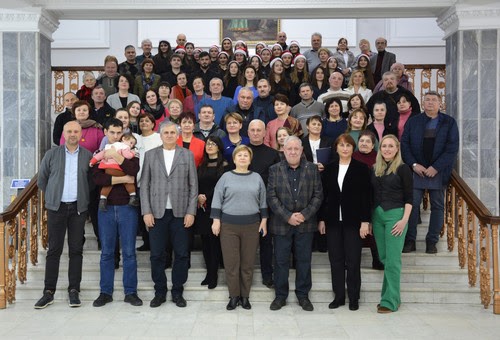  Events Archive Events Archive
The retrospective of the 2022
December 30, 2022
 Being in the middle of the years, it is time for each of us to make some conclusions and remember once again what the year 2022 was remembered for. Being in the middle of the years, it is time for each of us to make some conclusions and remember once again what the year 2022 was remembered for.
Following the removal of the restrictions imposed by the epidemiological situation in 2021, the National Museum of History of Moldova reopened its doors to the visiting public and was the host of numerous events, which aimed to promote culture, knowledge of national history and building a community of people who are united by a love of history. Our museum has been visited by thousands of people from different corners of the world, and hundreds of guided tours, workshops and thematic lessons have been organized. During the year, NMHM organized 27 temporary exhibitions with a broad theme, through which the museum's heritage was valued, while also giving the opportunity to our partners to contribute by organizing various joint exhibitions. During the year, we organized around 90 cultural, scientific and charity events, in the creation of which both the Museum team and our loyal partners - museums, accredited embassies in Chisinau, research institutions, educational institutions, non-governmental organizations, artists artists, performers, etc. During those events, we were happy to see in our halls a lot of beautiful people, who have already become our friends. Among the main events of the year we can highlight the International Night of Museums (14 May) and the International Day of Museums (18 May) which have already become a beautiful tradition and enjoyed immense success. In the field of research, the year 2022 was a very productive and memorable one. A lot of scientific events took place such as the National Scientific Conference "30 years since the War for the Defense of the Independence and Territorial Integrity of the Republic of Moldova (1992)" (February 25-26), the National Session of Archaeological Reports (2021 campaign) (20 April), the XVI Heraldry Symposium (April 27, 2022), the Round Table entitled "Archaeology of the Republic of Moldova through the prism of Moldovan-German relations" (September 6, 2022), crowning the year with one of the most prestigious scientific events in the Republic of Moldova - International scientific conference "History - Archeology - Museology", XXXII edition (October 27-28, 2022). During 2022, the "Tyragetia" Library was enriched by the appearance of some valuable works, such as "Currency and monetary circulation in the Principality of Moldova (1711-1859)" by Elena Arcuș-Jantovan, "Museum. Traditionalism and modernity" by Elena Ploșniță and the appearance of numbers 1 and 2 of volume XVI [XXXI] of Tyragetia magazine, new series: "Archaeology. Ancient History" and "History. Museology". In 2022, an important role in museum life was played by the Museum courtyard, which came to life not only through the multitude of children who played in it, but also through the fact that it was a place for socializing, where they were organized outdoor events, which have had a good reception with our audience and which we intend to continue in the coming year. Likewise, our yard has been the gathering place for motorcycle and vintage car lovers. Together, we met at events such as The Distinguished Gentlemans Ride (May 22nd), 100 Attaches (September 11th) and The Distinguished Gentleman's Drive - Pre 80s Classic Cars (September 25th), which attracted thousands of people, from small to large, who had a good time, communicated, laughed, listened to music and enthusiastically took pictures next to vintage motorcycles and cars. The past year was not an easy one at all, a year that faced us with many difficulties and dramatic moments, which only through joint actions we managed to face. In the context of the war in Ukraine, NMHM was a partner and host of several charity events, aimed at providing support to Ukrainian refugees and their children, for whom visits to the Museum became a moment of respiro in these complicated times. By organizing events dedicated to the support of people who fled the path of war, NMHM promoted the generally human values that everyone must demonstrate - kindness, generosity, empathy, and last but not least - helping people in need. Having said that, we thank everyone who stepped on the threshold of the National Museum of History of Moldova and everyone who was involved in organizing our exhibitions and events. We wish you that the year 2023 will be peaceful, prosperous and with many beautiful achievements. In the new year, we look forward to seeing you again in our halls, because NMHM is not just a place, NMHM are you - our visitors! Happy New Year!
|





















































